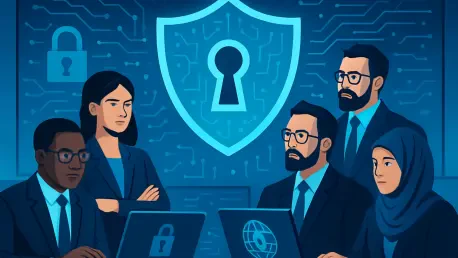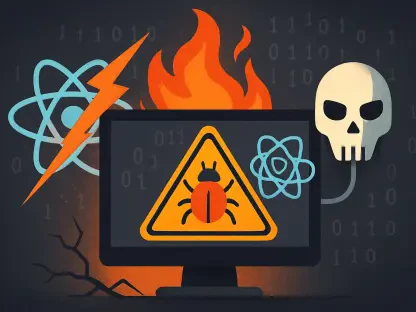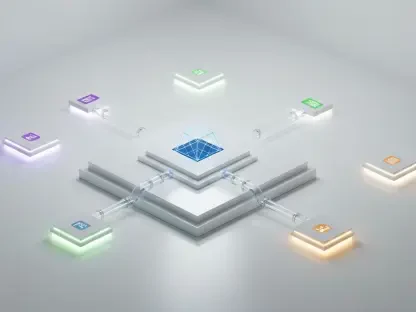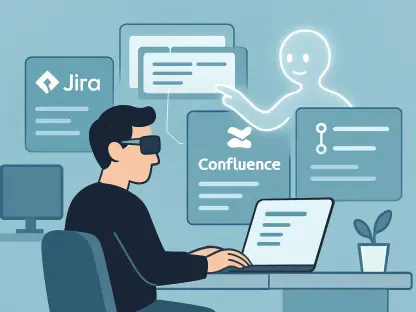In a world where digital connectivity underpins nearly every aspect of life, the cybersecurity landscape has become a critical battleground against increasingly sophisticated threats. As of 2025, cyberattacks are not just a risk but a persistent reality, targeting everything from personal data to national infrastructure with alarming precision. This comprehensive exploration delves into the top 100 cybersecurity leaders—both companies and individuals—who are at the forefront of defending the digital realm. These pioneers are not merely responding to threats but are proactively shaping strategies and technologies to neutralize risks before they materialize. From global corporations to niche innovators, their contributions span integrated platforms, cloud security, AI-driven automation, and human-centric approaches, addressing a threat landscape that evolves by the hour.
This guide offers an in-depth look at the visionaries driving change through innovation, market influence, and proven effectiveness in combating cybercrime. Businesses seeking reliable partners and individuals curious about the future of digital protection will find valuable insights into the tools, trends, and tactics defining cybersecurity today. The leaders highlighted here have been evaluated based on their ability to anticipate emerging risks, deliver scalable solutions, and fortify organizations against a wide array of challenges. Embark on this journey to uncover the guardians of the virtual world, whose work ensures that the digital age remains a space of opportunity rather than vulnerability.
Confronting an Escalating Cyber Threat Landscape
The digital environment in 2025 is marked by an unprecedented escalation in cyber threats, both in frequency and complexity, challenging even the most prepared organizations. Ransomware continues to cripple enterprises, while state-sponsored attacks target critical infrastructure with devastating potential, exploiting vulnerabilities in cloud systems, IoT devices, and remote work setups. Traditional defenses, once sufficient, are now outdated as hackers leverage advanced techniques to penetrate systems. The rapid digitization across industries has expanded the attack surface, making every connected device a potential entry point for malicious actors. Cybersecurity leaders are under immense pressure to develop solutions that can keep pace with these dynamic risks, ensuring that businesses and individuals remain protected in an interconnected world.
Beyond the sheer volume of attacks, the sophistication of adversaries has reached new heights, with artificial intelligence being weaponized to create nearly undetectable phishing campaigns. Zero-day exploits target unpatched systems with surgical accuracy, often before organizations can react. The financial and reputational costs of data breaches are staggering, frequently running into millions of dollars and eroding public trust. Regulatory frameworks like GDPR and CCPA add further complexity, imposing strict compliance requirements that organizations must navigate alongside their security efforts. The top leaders in cybersecurity are not only building defenses against these threats but also ensuring that legal and ethical standards are met, creating a dual focus on protection and accountability.
Human error persists as a significant vulnerability, often exploited through social engineering tactics that trick employees into compromising sensitive systems. Despite advancements in technology, the human factor remains a weak link that attackers target relentlessly. Cybersecurity pioneers are addressing this gap by integrating user education and awareness into their strategies, recognizing that a robust defense requires both technical and behavioral components. By fostering a culture of vigilance, these leaders aim to build a human firewall that complements technological barriers. As threats continue to evolve, the need for comprehensive, adaptive solutions becomes ever more apparent, setting the stage for the innovators who are redefining digital defense.
Champions of Integrated Security Ecosystems
In 2025, the shift toward integrated security platforms represents a fundamental change in how organizations fortify their defenses against multifaceted threats, marking a significant evolution in cybersecurity strategies. Companies like Palo Alto Networks lead this charge with unified systems that merge next-generation firewalls, endpoint protection, and cloud security into a single, cohesive framework. This approach tackles the complexity of managing disparate tools, which often leaves gaps for attackers to exploit. By providing a centralized management interface, such platforms enable IT teams to monitor and respond to threats with greater efficiency. The emphasis on integration reduces operational overhead, allowing businesses to focus on core activities while maintaining a robust security posture in an increasingly hostile digital environment.
Fortinet stands as another titan in this space, with its Security Fabric designed to ensure seamless communication across all security components. This interconnected system facilitates real-time threat intelligence sharing, enabling organizations to detect and mitigate incidents at lightning speed. Similarly, Check Point’s Infinity architecture offers a comprehensive suite that spans network, cloud, and mobile security, eliminating silos that hinder effective defense. Trellix also contributes significantly by integrating endpoint, network, and data security into a unified ecosystem, providing security teams with a panoramic view of potential risks. These leaders are driven by the understanding that coordinated attacks require equally coordinated defenses, a principle that underpins their innovative platforms.
The move toward integration is not merely a trend but a strategic necessity as cyber threats become more orchestrated and complex, demanding a unified defense to safeguard critical systems. Fragmented security tools often result in blind spots that sophisticated attackers can exploit with ease. By consolidating functions into streamlined systems, these companies empower organizations to close those gaps, ensuring that every layer of their digital infrastructure is protected. This holistic approach also simplifies compliance with regulatory standards, as centralized data and reporting make audits more manageable. The impact of these integrated ecosystems is profound, reshaping how businesses approach cybersecurity and setting a new standard for resilience against evolving risks.
Innovators in Cloud Security and Zero Trust Models
With cloud adoption reaching unprecedented levels in 2025, securing distributed environments has emerged as a critical priority for cybersecurity leaders. Zscaler is at the forefront, championing Secure Access Service Edge (SASE) solutions that deliver cloud-native security for remote workforces through strict access controls. Their technology inspects traffic inline, ensuring threats are intercepted before reaching critical systems. Cloudflare complements this effort by integrating network performance with security, offering a SASE framework that prioritizes both speed and protection. Netskope excels in securing multi-cloud setups with advanced data loss prevention tools, while their Cloud Security Posture Management (CSPM) capabilities help organizations identify misconfigurations that could lead to breaches. These leaders are redefining security for a borderless digital landscape.
iboss plays a pivotal role with its Zero Trust Network Access (ZTNA) solutions, continuously verifying users and devices regardless of location, effectively dismantling the outdated notion of a trusted perimeter. Specialists like Wiz bring innovation through agentless cloud security platforms, scanning for vulnerabilities across major providers like AWS, Azure, and GCP. Aqua Security focuses on container and workload protection, embedding security into DevOps pipelines to safeguard cloud-native applications from inception to deployment. Orca Security offers a similar agentless approach, providing deep visibility into cloud risks and prioritizing critical threats for swift remediation. Zero Trust Segmentation leaders like Illumio, Guardicore, and ColorTokens further enhance defenses by preventing lateral movement within networks, ensuring breaches are contained.
The consensus among these innovators is unmistakable: the cloud demands a perimeter-less security model that traditional approaches cannot provide. As organizations increasingly operate in distributed environments, the risk of exposure grows exponentially, necessitating solutions that adapt to dynamic infrastructures. Zero Trust principles, which assume no user or device is inherently safe, form the backbone of their strategies, ensuring that every access request is rigorously vetted. This focus on cloud-native and Zero Trust architectures addresses the unique challenges of modern IT landscapes, protecting data and systems in a world where physical boundaries no longer define security. Their leadership ensures that businesses can embrace cloud technologies without sacrificing safety.
Trailblazers in AI and Automation for Threat Response
Artificial Intelligence (AI) is transforming the cybersecurity arena in 2025, with leaders like CrowdStrike leveraging their Falcon platform to deliver real-time endpoint detection and automated threat responses. By harnessing machine learning, they neutralize fast-moving threats like ransomware before significant damage occurs, reducing reliance on manual intervention. SentinelOne’s Singularity XDR platform mirrors this approach, using AI to detect and remediate incidents autonomously, alleviating the burden on understaffed security teams. This capability is especially crucial given the global shortage of skilled cybersecurity professionals, allowing organizations to maintain robust defenses despite resource constraints. The integration of AI ensures that responses are not only swift but also precise, targeting the root of threats with minimal collateral impact.
Darktrace sets itself apart with Self-Learning AI that adapts to an organization’s unique network patterns, identifying anomalies that signal novel threats without relying on known attack signatures. Vectra AI focuses on uncovering hidden dangers in encrypted traffic, a growing challenge as attackers use encryption to cloak their activities. Their AI-driven insights enable organizations to detect stealthy intrusions that might otherwise go unnoticed. These leaders recognize that the sheer volume and velocity of modern cyber threats outstrip human capabilities, necessitating intelligent systems that can analyze vast datasets in real time. Automation also mitigates alert fatigue by prioritizing high-risk incidents, ensuring that security teams focus their efforts where they matter most.
Beyond detection, AI is increasingly used for predictive analysis, enabling organizations to anticipate attack patterns before they manifest, thus staying one step ahead of potential threats. These trailblazers are reshaping security operations centers by embedding intelligent automation into workflows, enhancing efficiency and responsiveness. Their hybrid model, which balances AI with human oversight, ensures that technology augments rather than replaces expertise, addressing both routine and complex threats. The future of cybersecurity hinges on such intelligent systems, and these innovators are paving the way for defenses that evolve as rapidly as the threats they combat. Their contributions underscore a pivotal shift toward proactive, data-driven security in an era of relentless digital risk.
Endpoint and Extended Detection Defenders
Endpoint security remains a foundational element of cybersecurity in 2025, with Microsoft Security leading the charge through its Defender suite, which integrates endpoint protection with cloud and identity tools for comprehensive coverage. Broadcom, through its Symantec division, offers robust Endpoint Protection Platforms (EPP) that shield against malware and advanced persistent threats, catering to enterprise-scale needs. VMware Carbon Black provides cloud-native endpoint detection and response (EDR), using behavioral analysis to halt attacks with minimal performance impact. Cybereason enhances this space with EDR solutions that correlate endpoint events to reveal the full scope of an attack, aiding in faster resolution. These defenders address the reality that endpoints are often the initial entry point for attackers, making their protection a critical first line of defense.
The evolution toward Extended Detection and Response (XDR) marks a significant advancement, with Trellix integrating endpoint data with network and cloud insights for a holistic threat perspective. Stellar Cyber pushes XDR boundaries by automating threat hunting across environments, while their open architecture supports integration with existing tools. Hunters Security leverages AI to connect disparate data points, improving detection accuracy and response speed across systems. This shift to XDR reflects the interconnected nature of modern IT environments, where attacks span multiple domains, requiring a unified approach to visibility and mitigation. By blending endpoint security with broader insights, these leaders ensure that organizations are not blindsided by threats that move laterally through networks.
The importance of endpoint and XDR solutions cannot be overstated in a landscape where remote work and mobile devices expand vulnerabilities, creating a pressing need for robust security measures. These defenders provide the tools needed to secure every device, whether in the office or halfway across the globe, preventing breaches from escalating into widespread incidents. Their focus on integration and automation reduces the complexity of managing diverse endpoints, allowing security teams to maintain control over sprawling infrastructures. As threats grow in sophistication, their innovations offer a dynamic shield, adapting to new attack vectors while maintaining a user-friendly approach. Their leadership in this domain ensures that the first point of contact for many attacks is also the strongest point of defense.
Advocates for Human-Centric Security Measures
Despite technological advancements, human error remains a leading cause of cybersecurity breaches in 2025, prompting leaders like Proofpoint to focus on email security solutions that combat phishing and business email compromise with precision. Their advanced filtering mechanisms stop malicious messages before they reach inboxes, addressing one of the most common attack vectors. Mimecast complements this effort with sophisticated email protection tools that detect and block social engineering attempts, ensuring that employees are not unwitting gateways to organizational systems. These companies understand that while firewalls and encryption are vital, they cannot fully mitigate risks posed by human oversight, necessitating targeted defenses at the user interaction level.
KnowBe4 takes a unique approach by prioritizing security awareness training, using simulated phishing campaigns to educate employees on recognizing and reporting suspicious activities. This builds a human firewall, transforming staff into active defenders rather than liabilities. Cofense aligns with this philosophy, offering training alongside phishing response tools that empower users to play a direct role in security. Their solutions integrate behavioral science to make vigilance instinctive, significantly reducing the likelihood of successful social engineering attacks. By addressing risks like weak passwords and improper data handling through ongoing education, these leaders ensure that the workforce becomes a strength rather than a vulnerability in the cybersecurity chain.
The emphasis on human-centric security reflects a broader industry realization that technology alone cannot safeguard organizations, and employees, often targeted through deceptive tactics, must be equipped with the knowledge and tools to resist manipulation. These innovators blend practical training with robust technical barriers, creating a balanced security posture that tackles both infrastructure and behavior. Their measurable impact is evident in reduced incident rates among organizations that invest in such programs, demonstrating that user empowerment is as critical as any software solution. By fortifying the human element, these advocates address a perennial challenge, ensuring that digital defenses are comprehensive and resilient.
Specialists Addressing Niche Cybersecurity Needs
Not every cybersecurity challenge can be met with a universal solution, and in 2025, niche specialists are filling critical gaps with targeted expertise. Dragos focuses on industrial cybersecurity, protecting operational technology in critical infrastructure sectors like energy and manufacturing from sophisticated attacks. Claroty mirrors this dedication, safeguarding industrial control systems with deep knowledge of unique OT risks often overlooked by broader vendors. Their specialized tools ensure that utilities and factories, which underpin societal function, are not left vulnerable to targeted disruptions. This focus on niche areas highlights the diversity of threats and the need for tailored defenses that address specific industry pain points.
In the realm of software development, Snyk leads with application security solutions that integrate vulnerability testing into the development lifecycle, enabling developers to address issues before deployment. GitLab offers comparable capabilities, embedding security scans into DevOps workflows to balance speed with safety. Checkmarx excels in static and dynamic application testing, catching flaws early, while Veracode provides comprehensive analysis and penetration testing for continuous security. OneTrust tackles privacy and compliance, helping organizations navigate complex regulations like GDPR with governance tools. These specialists ensure that specific risks—whether in code, data privacy, or industrial systems—are met with precise, effective solutions.
The value of niche expertise lies in its ability to complement broader security platforms, offering organizations a layered defense strategy that ensures comprehensive protection. While general solutions provide overarching protection, these targeted tools address vulnerabilities unique to particular sectors or processes, ensuring no area is left exposed. Their contributions are vital in an era where attacks are increasingly customized to exploit specific weaknesses, from insecure applications to unprotected critical infrastructure. By meeting diverse needs with specialized knowledge, these leaders enable businesses to secure every facet of their operations, reinforcing the importance of adaptability in cybersecurity strategies.
Providers of Managed Services and Expert Guidance
For many organizations in 2025, limited in-house cybersecurity resources pose a significant barrier to effective defense, a gap that managed services providers are uniquely positioned to bridge. Arctic Wolf offers Managed Detection and Response (MDR) with 24/7 monitoring by expert teams, acting as an extension of internal capabilities. Red Canary delivers similar MDR services, blending technology with human analysis to identify and neutralize threats swiftly. Secureworks caters to enterprise needs with managed security that combines automation and expertise for comprehensive coverage. Trustwave provides MDR alongside tailored consulting, helping businesses craft long-term strategies to address unique challenges. These providers ensure that even resource-constrained organizations can access top-tier protection.
Consulting giants like Deloitte offer strategic guidance, from risk assessments to incident response planning, aligning security with broader business objectives. PwC brings global expertise to help multinational enterprises integrate security into their operations, while EY focuses on transformative strategies to stay ahead of regulatory and threat landscapes. KPMG excels in risk management, ensuring compliance and security go hand in hand, and Accenture delivers end-to-end solutions by embedding security into IT transformations. These leaders provide not just technical support but also advisory services, enabling organizations to build resilient frameworks without the overhead of expansive internal teams.
The role of managed services and expert guidance is critical in democratizing access to advanced cybersecurity, especially since many businesses lack the budget or expertise to maintain dedicated security operations, leaving them vulnerable to sophisticated threats. By outsourcing to trusted providers, they gain access to cutting-edge tools and seasoned professionals, leveling the playing field against well-resourced attackers. This approach also allows for scalability, as services can be tailored to grow with the organization. The impact of these providers is evident in the enhanced security posture of their clients, proving that external expertise can be as effective as internal development in combating digital risks.
Visionaries in Threat Intelligence and Proactive Defense
Proactive defense is redefining cybersecurity in 2025, with threat intelligence leaders enabling organizations to anticipate risks before they strike. Recorded Future provides real-time insights from diverse sources, including the dark web, to uncover attacker plans in advance. Anomali transforms raw data into actionable intelligence through platforms that help predict and mitigate threats. ThreatConnect integrates intelligence with security operations, fostering collaboration to prioritize and address risks effectively. Intel 471 specializes in dark web monitoring, offering early warnings by exposing malicious intent before it materializes. These visionaries shift the industry from a reactive stance to one of foresight, fundamentally altering how threats are managed.
The value of threat intelligence lies in its ability to provide context, making technical defenses like firewalls and endpoint security more effective. By analyzing vast datasets to identify trends and patterns, these platforms enable organizations to preempt campaigns such as ransomware or espionage. Their tools are accessible not only to large enterprises but also to smaller firms, ensuring broad adoption across sectors. This democratization of intelligence empowers businesses of all sizes to stay ahead of adversaries, reducing the likelihood of successful attacks. The focus on understanding attacker behavior adds a strategic layer to cybersecurity, enhancing overall resilience.
The impact of proactive defense is measurable in reduced breach rates among organizations that leverage threat intelligence. Armed with predictive insights, businesses can neutralize risks before they escalate, a capability that traditional reactive measures cannot match. These leaders also foster collaboration by integrating intelligence into broader security workflows, ensuring that every defensive component benefits from informed decision-making. As threats grow in complexity, their emphasis on anticipation over reaction positions them as indispensable allies in the fight against cybercrime. Their innovations underscore a pivotal industry shift, prioritizing prevention as the cornerstone of modern digital defense.
Leaders in Networking and Security Convergence
The convergence of networking and security marks a defining trend in 2025, driven by leaders like Cato Networks, whose SASE platform unifies connectivity and protection in a cloud-native model. Zscaler, a dominant force in cloud security, advances this integration with solutions that ensure secure, fast access for distributed teams. iboss also champions this shift, blending secure web gateways with network access controls to eliminate reliance on traditional hardware. This trend reflects the obsolescence of perimeter-based security in a world where remote work and cloud adoption dissolve physical boundaries. These innovators are crafting frameworks where connectivity and safety are inseparable, addressing modern business needs.
This convergence reduces complexity for IT teams by eliminating the need to manage separate tools for networking and security, streamlining operations. It also cuts costs, as unified platforms remove the expense of maintaining multiple systems, a significant advantage for budget-conscious organizations. More importantly, their cloud-first approach aligns with the shift away from on-premises infrastructure, offering scalable alternatives that grow with business demands. Security and performance are no longer trade-offs but complementary strengths, as these leaders prove that fast networks can be fortified against threats. Their solutions ensure that user experiences remain seamless without compromising on robust defense.
The broader implications of this trend are transformative, as it redefines how organizations approach digital infrastructure and fosters a more integrated strategy for resilience. Traditional silos between networking and security teams are breaking down, creating a unified approach that enhances overall protection. As workforces become increasingly distributed, the need for cohesive systems that safeguard while enabling connectivity becomes paramount. These leaders are shaping a future where the lines between networking and security blur, creating a holistic model essential for defending the digital landscape. Their innovations provide a blueprint for businesses navigating the complexities of a borderless world, ensuring both efficiency and protection.
Proponents of Scalability and Simplicity in Security
Scalability and simplicity are paramount for cybersecurity solutions in 2025, as leaders like Sophos cater to small and mid-sized businesses with user-friendly, all-in-one platforms that deliver enterprise-grade protection. This focus ensures that even organizations with limited resources can safeguard their digital assets effectively against evolving threats.









